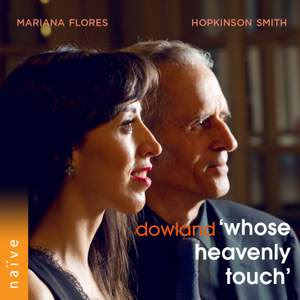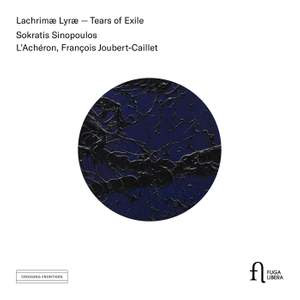Program: #20-12 Air Date: Mar 09, 2020
To listen to this show, you must first LOG IN. If you have already logged in, but you are still seeing this message, please SUBSCRIBE or UPGRADE your subscriber level today.
Hopkinson Smith with Mariana Flores, Phantasm and the Lachrimae, and the ensemble L’Archeron with a Greek take on the English composer!
I. John Dowland: Lachrimae or Seven Teares (Phantasm). Linn CD CKR 527.

John Dowland's gifts as an exceptional melodist are evident throughout Lachrimae or Seven Tears, an artistic achievement which has cast a remarkable spell on early music.
This wonderful album has won two major Early Music awards: the 2017 Gramophone Award and the 2017 Diapason d'or de l'année. It was also named a Building A Library: 'First Choice' by BBC Radio 3 - Record Review.
Summing up the Renaissance preoccupation with melancholy, this extraordinary collection of dance music for viols and lute includes Dowland's 'signature' piece, Semper Dowland semper Dolens. Dowland reveals a personal world of sublime sadness, grief, anger and melancholy mollified by moments of joy and gladness.
A skilled lutenist, Dowland's intricately-worked parts demand perfect synchronicity between Phantasm and Elizabeth Kenny, who rise to the technical and tempi challenges of marrying their instruments.
The popularity of Dowland's music in his own lifetime continued through the centuries with Lawes, Jenkins and Gibbons all paying homage to Dowland's 'Tears'. Although freed from lyric constraints poetic images linger prompting Phantasm's Laurence Dreyfus to describe this as ‘the most sensuously tuneful hour of music ever written'.
From Gramophone: How to describe Dowland’s Lachrimae, or Seaven Teares? Seven pavans for five-part viol consort with lute, each a subtle transformation of the pavan known in its song version as ‘Flow my tears’, would be a start, but hardly does justice to its patient flow of exquisitely drawn and closely summoned emotion. These are not ‘division’ variations but a sequence of new pieces, each related to its companions by the falling motif that opens the song but also by numerous significant cross-references between them. In Laurence Dreyfus’s words, they are ‘an extended process of reflection on a poetic-musical theme’.
Phantasm’s performances are totally convincing and absorbing. Drawing richly on their depth, intensity and homogeneity of tone, their acuity to the music’s ever-active emotional flux leaves them unafraid to use forceful gestures of articulation and dynamics to make a point. This keen awareness of the music’s power extends to their performances of the 14 other pieces Dowland included in his Lachrimae publication,
The CD is beautifully presented, with readable and insightful booklet articles by Dreyfus and Elizabeth Kenny. Dowland characterised his seven pavans as ‘passionate’, and one can sense the true passion of Dreyfus and his performers in what has all the hallmarks of a classic recording.
1 Lachrimae Antiquae 4:02
2 Lachrimae Antiquae Novae 3:28
3 Lachrimae Gementes 3:36
4 Lachrimae Tristes 3:50
5 Lachrimae Coactae 3:17
6 Lachrimae Amantis 3:56
7 Lachrimae Verae 4:02
8 Mr Nicholas Gryffith His Galliard 1:47
9 Sir John Souch His Galliard 1:30
10 Semper Dowland Semper Dolens 6:20
11 Mr Giles Hoby His Galliard 1:19
12 The King Of Denmark's Galliard 1:53
13 Mr Bucton His Galliard 1:16
14 The Earl Of Essex Galliard 1:17
15 Captain Piper His Galliard 1:23
16 Mr Henry Noell His Galliard 1:58
17 Mr Thomas Collier His Galliard With Two Trebles 1:22
18 Sir Henry Umpton's Funeral 4:15
19 Mr George Whitehead His Alman 1:46
20 Mrs Nichols's Alman 1:10
21 Mr John Langton's Pavan 3:55
II. Dowland: “Whose heavenly touch” (Mariana Flores, v./Hopkinson Smith, lute). Naive CD E 8941.

Here they give us a Dowland programme straight from the heart, drawing on five of the composer’s volumes of ‘Songs or Ayres’ printed in London between 1597 and 1612, laying bare Dowland’s ecstatic and tortured soul as it oscillates between all the different states of melancholy love.
3 O sweet woods
4 I saw my lady weep
5 Can she excuse my wrongs
6 All ye, whom love of fortune hath betray'd
7 Mignarda (instrumental)
8 Fine knacks for ladies
9 Now, o now, I needs must part
10 Come, heavy sleep
11 In darkness let me dwell
12 If my complaints could passions move
13 Wilt thou unkind thus reave me
14 Go crystal tears (instrumental)
15 Go crystal tears
16 Come again!
17 Sorrow, sorrow stay
III. Lachrimae Lyrae—Tears of Exile (Sokratis Sinopoulos, Greek lyra/L’Achéron Ensemble/François Joubert-Caillet). Fuga libera CD FUG 753.

2. Lachrimae Antiquae (After the Lachrimae or Seaven Teares, 1604)
3. Lachrimae Antiquae Novae (After the Lachrimae or Seaven Teares, 1604)
4. Sokratis Sinopoulos; L'Achéron; Francois Joubert-Caillet: Sheliak
5. Lachrimae Gementes (After the Lachrimae or Seaven Teares, 1604)
6. Lachrimae Tristes (After the Lachrimae or Seaven Teares, 1604)
7. Lachrimae Coactae (After the Lachrimae or Seaven Teares, 1604)
8. Lachrimae Amantis (After the Lachrimae or Seaven Teares, 1604)
9. Lachrimae Verae (After the Lachrimae or Seaven Teares, 1604)
10. Sokratis Sinopoulos; L'Achéron; Francois Joubert-Caillet: Sulafat
11. Sir John Souch his Galliard (After the Lachrimae or Seaven Teares, 1604)
12. Sokratis Sinopoulos; L'Achéron; Francois Joubert-Caillet: Aladfar
13. The King of Denmark Galliard (After the Lachrimae or Seaven Teares, 1604)
14. M. Giles Hobies his Galliard (After the Lachrimae or Seaven Teares, 1604)
15. Captaine Digorie Piper his Galliard (After the Lachrimae or Seaven Teares, 1604)
16. M. Bucton his Galliard (After the Lachrimae or Seaven Teares, 1604)
17. Sokratis Sinopoulos; L'Achéron; Francois Joubert-Caillet: Alathfar
18. M. Nichols Almand (After the Lachrimae or Seaven Teares, 1604)
19. The Earl of Essex Galliard (After the Lachrimae or Seaven Teares, 1604)
20. Semper Dowland semper Dolen (After the Lachrimae or Seaven Teares, 1604)
Composer Info
John Dowland
CD Info
Linn CD CKR 527, Naive CD E 8941, Fuga libera CD FUG 753